
All season snow tires are made differently from the normal tires to enable them to withstand the harsh environmental conditions due to the extremely low temperatures during snow.
- Rubber compound –the rubber used in the construction of snow or winter tires is usually soft to ensure that they remain tender throughout and that they don’t harden due to freezing. The soft rubber makes sure that the treads remain intact thus the top rated all season tires for snow don’t lose their grip on the slippery ice.
- Narrower –snow tires are crafted in a manner that they are narrower because reducing the width of a tire increases the pressure it exerts on the surface. Therefore, it is able to cut through the thick ice without getting stuck.
- Designed to move water –these auto rubbers for the road are designed in such a manner that they are covered with grooves that melts the top layer of ice into water facilitating easier movement.
- Shallower treads –snow auto tires come in shallower treads that carry away the water films created when the vehicle presses the ice and melts it. Therefore, the tires don’t get stuck on the water that is melted on the surface covered with snow.the best snow tires for a SUV Wider treads accumulate snow inside them which causes the tires to slide when it melts.
- Studs –winter vehicle tires have additional ceramic or metal studs attached on the treads in a systematic manner to increase the traction. This extra traction is necessary to minimize slipping and sliding and ensuring that there’s even distribution of the pressure exerted by the vehicle among all the wheels.
- Low rolling resistance –the rolling resistance should be lower than the tire’s resistance to slippage to ensure that the vehicle remains steady and it’s able to penetrate through the thick snow without spinning.
There is a lot that goes into making the best all season tires for snow that won’t slip on snowflakes. The goal is to increase friction between the tire and the surface.
